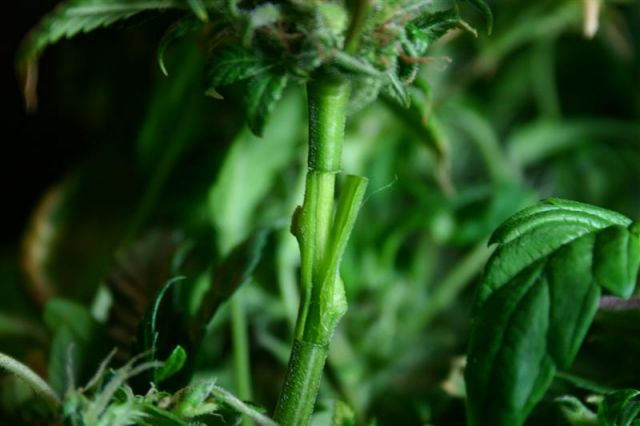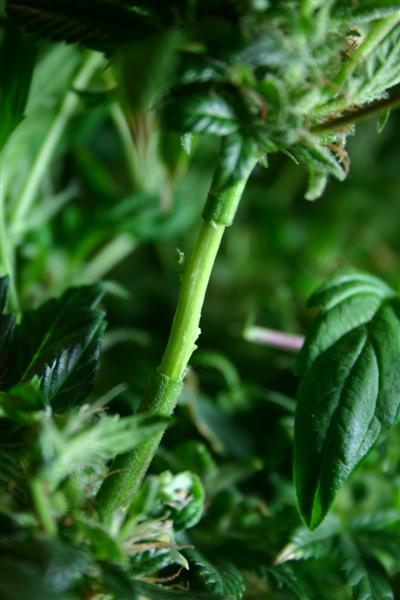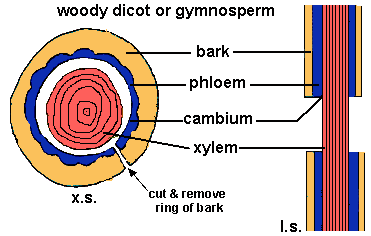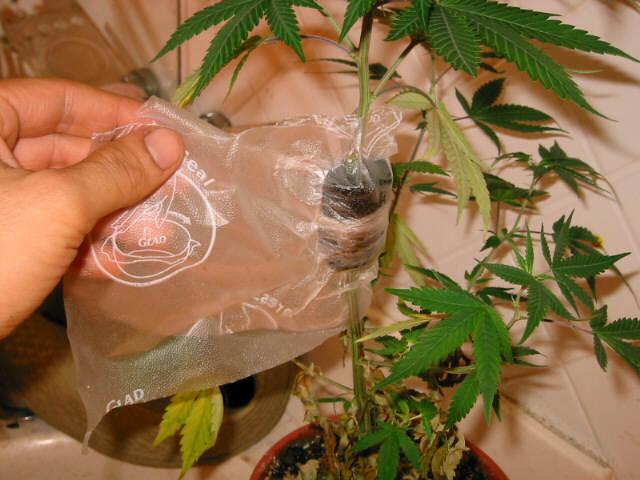

Loading

Clone Via Air-layering
Air-layering is a cloning method that roots the cutting fully before its ever cut from the mother, allowing massive clones to be taken without any down time- they vegetate and root simultaniously. within 2 weeks you can take a cut thats a fully rooted, thick stalked, lushly vegetated, almost 12in. tall plant, stick it in dirt and grow it.
Air layering is not a new tech, it is used often to reproduce trees, shrubs, and other plants for landscaping and agriculture. But ive never known anybody to use it on ganga(i am sure many people have), partially because of the labor involved and partly because of the lack of connection with the rest of the ag world outside of ganga that most of us have.
I have been experiencing wonderfull results in my testing of this tech, every air-layer i?ve done has taken in a week- no losses yet.
So i will outline the pros and cons of this technique and give a detailed description of how you can try this for yourselves.
Air-layering is a cloning method that roots the cutting fully before its ever cut from the mother, allowing massive clones to be taken without any down time- they vegetate and root simultaniously. within 2 weeks you can take a cut thats a fully rooted, thick stalked, lushly vegetated, almost 12in. tall plant, stick it in dirt and grow it.
Air layering is not a new tech, it is used often to reproduce trees, shrubs, and other plants for landscaping and agriculture. But ive never known anybody to use it on ganga(i am sure many people have), partially because of the labor involved and partly because of the lack of connection with the rest of the ag world outside of ganga that most of us have.
I have been experiencing wonderfull results in my testing of this tech, every air-layer i?ve done has taken in a week- no losses yet.
So i will outline the pros and cons of this technique and give a detailed description of how you can try this for yourselves.
Disadvantages (lets get the unpleasantries out of the way):
the biggest disadvantage to AL is that you could take 10 clones in the time it takes to do 1 AL, and it takes a semi-carefull hand for alot of the work, it?s not cut-and-plug simplicity.
Also, the size of mother plants and their branches must be larger than in a normal cloning system. longer vegetation is needed between time when cutting are reaped from the mother, to produce big thick branches. it also takes a bit to get the mother to where it can produce many cuts at once. you trade an endless supply of little cuttings for a few nice plants.
so, AL is far from a good idea for commercial opperators, and maybe not for the clumsy or care-lacking either.
I?m sure you will think of others.
the biggest disadvantage to AL is that you could take 10 clones in the time it takes to do 1 AL, and it takes a semi-carefull hand for alot of the work, it?s not cut-and-plug simplicity.
Also, the size of mother plants and their branches must be larger than in a normal cloning system. longer vegetation is needed between time when cutting are reaped from the mother, to produce big thick branches. it also takes a bit to get the mother to where it can produce many cuts at once. you trade an endless supply of little cuttings for a few nice plants.
so, AL is far from a good idea for commercial opperators, and maybe not for the clumsy or care-lacking either.
I?m sure you will think of others.
Advantages:
for a small grower who is limited in space, and wants just a few top-health plants for there head this allows for AMAZING clones to be taken and despite the work it will save time on your cycle.
here in the states we have plant limits on Medical permits- someplaces, like Cali, go by county regulation but most go by state regs. many people can only have 7-12 plants legally to give them there medicine...you see where i?m going, right?
untill you cut the clone from the mother its still only one plant, say you have 1 mother; 3 early flower; 3 late flower; normaly you can?t have more on your permit(and timing small harvests is a BITCH), well now you can have 6 more fully rooted plants on your mother just waiting for the first to harvest. great loophole if you ask me.
so combine the time saved on your cycle with the ability to have all your cuttings ready to plant when you harvest without risking breaking the law... and you have alot more smoke, more regularly, worry free.
furthermore, after the ALs have been set-up, they are very low maintanance and you don?t need to worry about them much- they grow vigerously.
for a small grower who is limited in space, and wants just a few top-health plants for there head this allows for AMAZING clones to be taken and despite the work it will save time on your cycle.
here in the states we have plant limits on Medical permits- someplaces, like Cali, go by county regulation but most go by state regs. many people can only have 7-12 plants legally to give them there medicine...you see where i?m going, right?
untill you cut the clone from the mother its still only one plant, say you have 1 mother; 3 early flower; 3 late flower; normaly you can?t have more on your permit(and timing small harvests is a BITCH), well now you can have 6 more fully rooted plants on your mother just waiting for the first to harvest. great loophole if you ask me.
so combine the time saved on your cycle with the ability to have all your cuttings ready to plant when you harvest without risking breaking the law... and you have alot more smoke, more regularly, worry free.
furthermore, after the ALs have been set-up, they are very low maintanance and you don?t need to worry about them much- they grow vigerously.
So heres how its done:
The branch to be cloned should be at least 1/8" thick. If the branch is too thin, it may not be able to hold itself up after doing this procedure.
Pick an area directly below or around a node, same as if you were to clone normally. Remove the outer layer of tissue, the phloem, by either scraping it off or cutting it as follows:
Make two cuts around the stem, just deep enough to cut through the outer layer. Cut too deeply and you will damage the inner xylem, disrupting water/nutrient flow to the leaves and possibly killing the branch. A sterilized scalpel or razor blade is used to make clean cuts. Connect the two cuts with a single vertical cut at the same depth. If done correctly, the phloem (bark) should simply peel off.
Pick an area directly below or around a node, same as if you were to clone normally. Remove the outer layer of tissue, the phloem, by either scraping it off or cutting it as follows:
Make two cuts around the stem, just deep enough to cut through the outer layer. Cut too deeply and you will damage the inner xylem, disrupting water/nutrient flow to the leaves and possibly killing the branch. A sterilized scalpel or razor blade is used to make clean cuts. Connect the two cuts with a single vertical cut at the same depth. If done correctly, the phloem (bark) should simply peel off.


Get clonex and apply it to the exposed xylem. For increased stability, you may tape a toothpick or matchsSuper Tree Hugger parrallel to the stem.
With thumb get some grow medium. (perlite, peatmoss, whatever) Pack the wound carefully with the soil.
With thumb get some grow medium. (perlite, peatmoss, whatever) Pack the wound carefully with the soil.


Attach plastic wrap below incision with tape. Tape the vertical seam where the ends meet. The effect of this should be a funnel shaped plastic wrap enclosure.
Pack with grow medium. Be sure to leave enough "slack" at the top so that it may be taped to the stem above the incision.
Fasten closed with tape.
Pack with grow medium. Be sure to leave enough "slack" at the top so that it may be taped to the stem above the incision.
Fasten closed with tape.


The biggest challenge to using this technique is keeping the medium moist. If it dries out, the sensitive tissues will die and you'll just end up with a dying/dead branch on your plant. After a couple of weeks, some roots should be growing from the wound site and the branch can be cut below the medium and transplanted.

